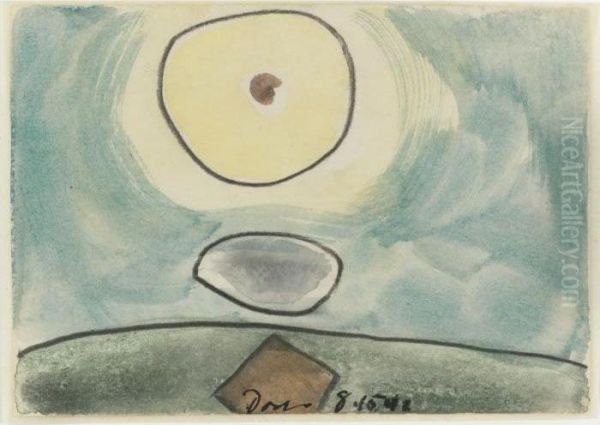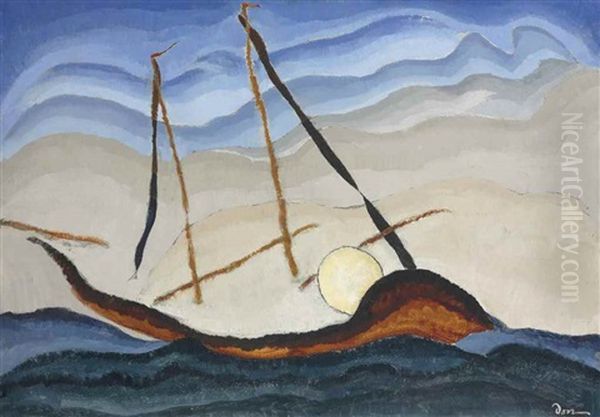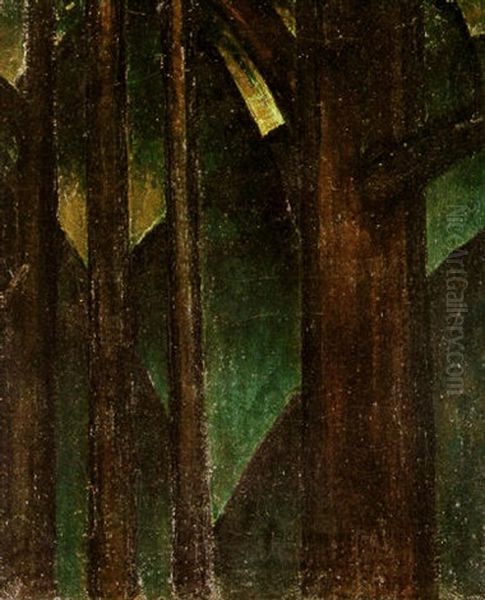
Arthur Garfield Dove stands as a seminal figure in the annals of American art, widely celebrated as one of the nation's first and most dedicated abstract painters. His journey from a conventional upbringing to the vanguard of modernism is a testament to his unique vision and unwavering commitment to exploring the essence of the world around him through non-representational forms. Dove's art, deeply rooted in nature yet expressed through a revolutionary visual language, carved a distinct path that continues to inspire and resonate within the art world.
Early Life and Artistic Awakening
Born on August 2, 1880, in Canandaigua, New York, Arthur Garfield Dove grew up in a prosperous family. His father, William George Dove, was a successful building contractor and brick manufacturer, providing a comfortable, if somewhat conventional, environment for young Arthur. His early interest in art was nurtured by a neighbor, Newton Weatherly, a naturalist who introduced Dove to painting. Despite this burgeoning passion, Dove initially pursued a more traditional academic path, enrolling at Cornell University in 1900.
At Cornell, Dove studied law, likely to appease familial expectations. However, his artistic inclinations soon took precedence. He became known for his illustrations for the university's yearbook and humor magazine. It was during these formative years that he decided to dedicate his life to art, a decision that would set him on a course far removed from the legal profession. After graduating in 1903, Dove moved to New York City, embarking on a career as a commercial illustrator. He found considerable success, contributing to popular publications such as Harper's Magazine and The Saturday Evening Post. This work, while providing financial stability, was ultimately a means to an end, allowing him to pursue his deeper artistic ambitions.
The European Sojourn: Seeds of Modernism

A pivotal moment in Dove's artistic development came in 1907 when he and his first wife, Florence Dorsey, traveled to Europe. They settled in Paris, then the undisputed epicenter of the avant-garde art world. This period, though relatively brief (lasting until 1909), was transformative. Dove immersed himself in the radical new art movements that were challenging centuries of academic tradition. He encountered firsthand the vibrant colors and expressive brushwork of Fauvism, championed by artists like Henri Matisse and André Derain. He also absorbed the structural innovations of Cubism, pioneered by Pablo Picasso and Georges Braque, and the emotional intensity of early Expressionism.
During his time in France, Dove associated with a group of American expatriate artists, including Alfred Maurer and Max Weber, who were also exploring these new artistic frontiers. Dove's talent was recognized, and he exhibited his work at the prestigious Salon d'Automne in both 1908 and 1909. This exposure to European modernism profoundly shaped his artistic vision, instilling in him a desire to break free from representational constraints and explore a more personal, abstract language. He began to experiment with simplifying forms and using color for its emotive and structural qualities rather than purely descriptive purposes.
Return to America and the Stieglitz Circle
Upon his return to the United States in 1909, Dove found an American art scene that was still largely conservative. However, a nascent modernist movement was beginning to take root, largely fostered by the visionary photographer and gallerist Alfred Stieglitz. Dove soon connected with Stieglitz, who became a crucial supporter and lifelong friend. Stieglitz's gallery, "291" (named for its address at 291 Fifth Avenue), was a beacon for avant-garde art in America, introducing European modernists like Picasso, Matisse, and Paul Cézanne to American audiences, alongside promoting pioneering American artists.
Dove became a key member of the Stieglitz Circle, a group that included other groundbreaking artists such as Marsden Hartley, John Marin, Georgia O'Keeffe (who would later marry Stieglitz), and Charles Demuth. In 1910, Stieglitz included Dove's work in the "Younger American Painters" exhibition at 291. By 1912, Dove had his first solo exhibition at the gallery, showcasing a series of abstract pastels known as "The Ten Commandments." These works are often cited as among the very first purely abstract artworks produced by an American artist, predating even the abstract explorations of Wassily Kandinsky in Europe for some pieces. This marked Dove's definitive break from representational art and his emergence as a pioneer of American abstraction.
The Essence of Nature: Dove's Artistic Philosophy

Dove's abstraction was not born from intellectual theory alone; it was deeply and inextricably linked to his profound connection with the natural world. He sought to capture the underlying forces, rhythms, and spiritual essence of nature rather than its superficial appearance. He famously described his process as "extraction," by which he meant distilling the essential qualities of his subject – be it a landscape, a sound, or an emotion – into abstract forms, colors, and lines.
He believed that art should communicate directly to the senses and emotions, much like music. Indeed, music was a significant inspiration for Dove, and he often sought to create visual equivalents of auditory experiences. His paintings frequently evoke the sounds of wind, rain, or foghorns, or the feeling of sunlight and shadow. This synesthetic approach, where one type of sensory stimulation evokes sensations in another, was a hallmark of his work. Unlike some of his European contemporaries who moved towards pure, non-objective abstraction, Dove's art, however abstract, almost always retained a tangible link to the observed world, drawing its power from the specificities of the American landscape he inhabited. He was influenced by the transcendentalist philosophies of Ralph Waldo Emerson and Henry David Thoreau, who emphasized the spiritual significance of nature.
Innovations in Material and Form
Arthur Dove was not only an innovator in terms of abstract imagery but also in his experimental use of materials and techniques. While he worked extensively with traditional oil paints and pastels, he also ventured into collage and assemblage, incorporating unconventional materials into his artworks. This practice began in the 1920s and demonstrated his desire to break down the barriers between art and life, and to find artistic potential in the everyday.
His assemblages often combined found objects with painted elements. For example, in works like The Intellectual (1925), he used a magnifying glass and a ruler, while Goin' Fishin' (1925) incorporated bamboo, denim, and wood. Monkey Fur (1926) famously utilized actual monkey fur alongside corroded metal, tin foil, and fabric. These works challenged conventional notions of what constituted fine art and prefigured later developments in assemblage and mixed-media art. His use of materials was not arbitrary; each element was chosen for its textural qualities and its ability to contribute to the overall expressive power of the piece. He also experimented with different paint mediums, sometimes mixing oil with wax or other substances to achieve unique surface effects, as seen in works like Snow and Water, an oil on aluminum panel.
Key Works and Thematic Explorations

Throughout his career, Dove produced a rich and varied body of work. His early abstract pastels, such as those from "The Ten Commandments" series (circa 1911-12), were groundbreaking in their bold simplification of natural forms into dynamic, almost calligraphic shapes and vibrant colors. These works, like Nature Symbolized No. 2, demonstrated his early commitment to "extraction."
As his style evolved, Dove continued to explore the themes of nature, sound, and motion. Works like Fog Horns (1929) use concentric circles and muted tones to visually represent the mournful sound of foghorns echoing across the water. Chinese Music (1923), a striking assemblage using metal and oil paint on wood, attempts to translate the percussive and melodic qualities of music into visual form.
The 1930s saw some of his most iconic paintings. Me and the Moon (1937) is often considered a career highlight, a mystical and evocative nocturnal landscape where the moon and its reflection are transformed into powerful, biomorphic shapes, imbued with a sense of cosmic wonder. The painting captures a deeply personal and spiritual connection to the natural world. Sunrise III (1936), with its radiating bands of color, conveys the energy and brilliance of a sunrise with an almost spiritual intensity. Tanks (1938), while seemingly depicting industrial forms, imbues them with an organic, almost living quality, characteristic of Dove's ability to find the vital essence in all things. His Space Divided by Line Motive series from the early 1940s explored a more geometric and planar abstraction, focusing on the precise interplay of color and line.
Life's Rhythms: Personal Challenges and Artistic Perseverance
Despite his artistic innovations and the support of Stieglitz, Dove struggled financially for much of his life. Commercial success largely eluded him, and he often had to take on farming or fishing to make ends meet. His personal life also saw its share of upheavals. His first marriage to Florence Dorsey ended in divorce. He later found a deep personal and artistic connection with Helen Torr, also an artist and part of the Stieglitz circle, whom he married in 1932. "Reds," as Torr was known, was a constant companion and a supportive artistic peer.
For many years, Dove and Torr lived a somewhat isolated life, often on a houseboat named "Mona" on the Long Island Sound, or in small, rustic homes in upstate New York and later on Long Island. This close proximity to nature was essential to his art, but it also meant a life of relative hardship. Duncan Phillips, the founder of The Phillips Collection in Washington, D.C., became an important patron in Dove's later years, providing some financial stability by purchasing his works regularly. Despite periods of ill health, including heart disease and kidney problems, Dove continued to paint with remarkable dedication until his death on November 23, 1946, in Huntington, New York.
Connections and Contemporaries
Arthur Dove's artistic journey was interwoven with many of the leading figures of early 20th-century modernism. His most significant relationship was undoubtedly with Alfred Stieglitz, whose unwavering belief in Dove's talent provided crucial exposure and moral support. Within the Stieglitz Circle, Dove shared artistic dialogues with John Marin, whose watercolors captured the dynamism of urban and natural landscapes; Marsden Hartley, known for his bold, symbolic abstractions; and Georgia O'Keeffe, whose magnified depictions of flowers and Southwestern landscapes shared Dove's deep reverence for nature, albeit expressed in a different visual language.
Dove's early exposure to European modernism in Paris connected him with the work of Henri Matisse, whose Fauvist use of color was a liberating influence, and Pablo Picasso, whose Cubist deconstruction of form opened new possibilities for pictorial space. The spiritual and abstract explorations of Wassily Kandinsky, particularly his treatise Concerning the Spiritual in Art, also resonated with Dove's own inclinations, although Dove developed his abstraction independently and with a distinctly American character. He was also aware of the work of other European modernists like Francis Picabia and Marcel Duchamp, who were introduced to America through Stieglitz and the Armory Show of 1913.
While Dove was a pioneer, he was part of a broader wave of American artists seeking a new, modern voice. Contemporaries like Charles Sheeler and Stuart Davis explored different facets of modernism, with Sheeler focusing on Precisionism's clean lines and industrial subjects, and Davis on a vibrant, jazz-inflected Cubism. Dove's unique contribution was his lyrical, nature-based abstraction, which set him apart yet placed him firmly within the vanguard of American artistic innovation. He also influenced younger artists, including Charles Demuth, another member of the Stieglitz group known for his Precisionist works and watercolor still lifes.
Legacy and Enduring Influence
Arthur Garfield Dove's legacy is that of a true pioneer. He was among the first artists in the world, and arguably the very first American, to create purely abstract paintings. His commitment to an art form that was, for many years, misunderstood and undervalued, required immense courage and conviction. He demonstrated that abstraction could be a deeply personal and expressive language, capable of conveying profound emotional and spiritual truths.
His emphasis on the inherent qualities of the natural world, distilled into abstract form, provided a uniquely American contribution to international modernism. He showed that abstraction did not have to be divorced from experience or emotion but could be a powerful means of connecting with the essence of life. His experimental use of materials and his exploration of synesthesia also prefigured later artistic developments.
While he may not have achieved widespread fame or financial success during his lifetime, his importance has been increasingly recognized by art historians and institutions. His works are now held in major museum collections across the United States, including The Phillips Collection, the Metropolitan Museum of Art, the Whitney Museum of American Art, and the Art Institute of Chicago. Exhibitions of his work continue to reveal the depth and complexity of his artistic vision. Arthur Dove's art paved the way for subsequent generations of American abstract artists, including the Abstract Expressionists of the post-World War II era, by establishing abstraction as a viable and powerful mode of artistic expression in the United States.
Conclusion
Arthur Garfield Dove was more than just a painter; he was a visionary who dared to see the world differently and to translate that vision into a new artistic language. His life was a testament to the pursuit of an authentic artistic voice, often in the face of adversity. Through his "extractions" from nature, his innovative use of materials, and his profound belief in the spiritual power of art, Dove created a body of work that is both uniquely American and universally resonant. As one of the earliest and most consistent practitioners of abstract art, his contributions were fundamental to the development of modernism in America, securing his place as a pivotal figure in 20th-century art history.